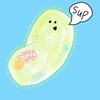Unit 2 | Cells | 7.E.1.1 - Protists Flashcards
7.E.1.1 | Compare the structures and life functions of single-celled organisms that carry out all of the basic functions of life including: • Euglena • Amoeba • Paramecium • Volvox
What is a protist?
A one-celled (aka unicellular) organism that is eukaryotic, meaning they have a nucleus.
Click hereto read more about protists.

What is an euglena?
A type of protist that is both plant- and animal-like.
- Moves: using a flagellum (pl. flagella)
- Eats: makes own food or eats other food.
- Unique features: some contain chlorophyll (allowing it to make its own food), and a red eyespot which guides it to light.
NOTE:
- Plant-like: it contains chlorophyll
- Animal-like: lacks cell wall (which all plants have).

What is an amoeba?
A one-celled (unicellular) protist.
- Moves: using it pseudopods (finger-like structures)
- Eats: surrounds the food and engulfs it!
- Unique features: psudopods
Click hereto watch an amoeba eat!

What is a paramecium?
The most complex and specialized of the protists.
- Moves using: cilia (small hair-like structures along its body).
- Eats: by using cilia to sweep food into its oral groove (mouth).
- Unique features: most complex protist

What is a volvox?
A colony of individual alga cells working together.
- Move: individual cells use 2 flagella, and all propel the colony in the same direction
- Eats: primarily through photosynthesis
- Unique features: contain red eyespots, live in colonies, some contains chlorophyll

What are pseudopods?
A temporary projection of cytoplasm, or a ‘‘false foot,” used by some protists for feeding or movement.

What is an autotroph?
An organism that can make its own food, usually through the process of photosynthesis.

What is a heterotroph?
An organism that cannot make its own food.

What is a flagellum (pl. flagella)?
A long, thin tail-like structure, almost like a whip, that enables many protozoa to swim.

What is chlorophyll?
A green pigment that absorbs sunlight allowing an organism to do photosynthesis.
Volvox and some euglena contain this, allowing them to make their own food through photosynthesis.

What is a red eyespot?
A structure in euglena and some volvox which guides the organism towards the light.

What are cilia?
Slender, microscopic, hair-like structures or organelles that extend from the surface of certain protists and help them move/swim.


